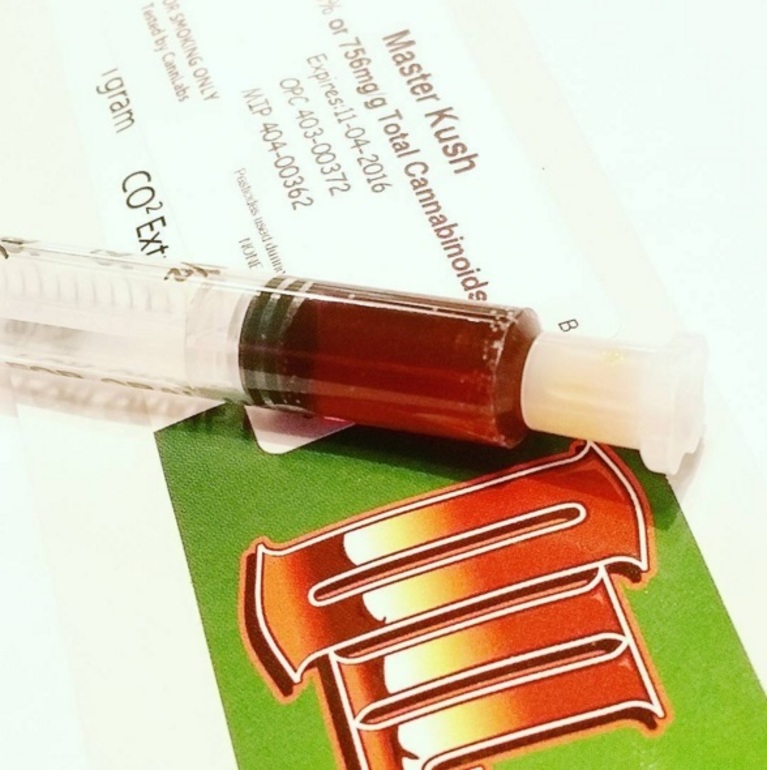Hanna Kyla-Junnila
What is a cannabis concentrate?
Under the general term of cannabis concentrates falls any product obtained through an extraction process. Solvents (i.e. butane, propane, CO2, ethanol) are used to strip the cannabinoids and terpenes from the cannabis plant, leaving behind a highly concentrated, highly potent end product.
It is important to note that the solvent used for extraction goes through a rigorous purge and evaporation process, and should not be residual in the finished product. Of course it is best to ask if the concentrates at your dispensary are lab tested to ensure that no residual solvents are left behind.
 Cannabis concentrate subculture is emerging quickly as patients enjoy the therapeutic effects of cannabis concentrates without having to combust plant material. Some concentrates in the market boast 90%+ THC levels and can be very therapeutic for a number of conditions such as chronic pain, sleep disorders, and mood disorders, by flooding your system with cannabinoids in a short amount of time.
Cannabis concentrate subculture is emerging quickly as patients enjoy the therapeutic effects of cannabis concentrates without having to combust plant material. Some concentrates in the market boast 90%+ THC levels and can be very therapeutic for a number of conditions such as chronic pain, sleep disorders, and mood disorders, by flooding your system with cannabinoids in a short amount of time.
It is also important to note that cannabis concentrates can be achieved without the use of solvents (i.e. kief, rosin, ice water hash extractions) thus eliminating concerns of residual solvents as well as tedious purge and evaporation processes. This greatly benefits both patients who are looking for all natural cannabis concentrates, and the cannabis industry as it gains interest in accommodating these needs.
In this article we will look at the various cannabis concentrates available in today’s market and explore the nuances of each concentrate.
-KIEF-
 Also known as dry-sift or pollen, kief is comprised of the resin glands that form on the flowers, leaves, and stems of the cannabis plant. Although cannabis without kief still contains cannabinoids, it is the resin glands that develop on the flowers that give off the strong psychoactive effects. These trichomes contain a variety of cannabinoids (THC, CBD, CBN, etc.) and terpenes that are trapped in the head of the resin gland.
Also known as dry-sift or pollen, kief is comprised of the resin glands that form on the flowers, leaves, and stems of the cannabis plant. Although cannabis without kief still contains cannabinoids, it is the resin glands that develop on the flowers that give off the strong psychoactive effects. These trichomes contain a variety of cannabinoids (THC, CBD, CBN, etc.) and terpenes that are trapped in the head of the resin gland.
Extraction Method
Luckily, extracting kief is very simple. If you have a grinder at home that is multi-chambered you would simply grind your herb for consumption, and after a few good uses the bottom compartment of your grinder should have a nice sprinkling of kief.
Another extraction option that is especially optimal for larger quantities of bud is to sift the cannabis with a fine mesh sifter. It is important to use very fine mesh, as this prevents plant material from slipping through the sifter during the separation process. Once the kief has been separated, a lot of consumers enjoy sprinkling their kief onto ground cannabis for more potent consumption, or turn their collection of kief into hash. Hash is kief that has been heated and pressurized.
Pressurizing kief also changes its colour; the more pressure applied, the darker the hash..
-BUTANE HONEY OIL (BUTANE HASH OIL)-
 Perhaps one of the most common extracts on the market, BHO is known by many other nicknames (shatter, budder, wax, oil, crumble, sugar wax, sap, pull-and-snap) which originate from the extract’s consistency. While the basic principles of extraction are the same across all these, differences in texture and appearance are mostly due to the finishing process..
Perhaps one of the most common extracts on the market, BHO is known by many other nicknames (shatter, budder, wax, oil, crumble, sugar wax, sap, pull-and-snap) which originate from the extract’s consistency. While the basic principles of extraction are the same across all these, differences in texture and appearance are mostly due to the finishing process..
Extraction Method
To make a butane extract, butane is pressurized in a large column and washed over plant material. Most starting plant material is dried and cured; some extract artists use fresh frozen plant material; more information on that below. After this washing, the remaining solution is collected. Extract artists must ensure that no residual solvents are left in the solution, so the next step is to purge and evaporate the solvent from the solution. Heat and vacuum is applied to make this purge process faster while still retaining flavourful terpenes and cannabinoids in the end product.
Most butane extractions are made with dried and cured cannabis flowers, however, some extract artists prefer to freeze the flowers when fresh in order to trap the flavourful and aromatic terpene profiles. That being said, dried and cured flower extraction will produce a fine extract, just not as flavourful and pungent. This fresh frozen extraction method produces an end product known as “live resin.”.
-CO2 OIL-
 Carbon dioxide (CO2) is a naturally occurring compound that leaves behind no residues, making it ideal for cannabis extractions. Moreover, CO2 extraction helps to ensure that these cannabis concentrates are pure and safe to consume, making this medicine fitting for patients who are in search of natural cannabis concentrates..
Carbon dioxide (CO2) is a naturally occurring compound that leaves behind no residues, making it ideal for cannabis extractions. Moreover, CO2 extraction helps to ensure that these cannabis concentrates are pure and safe to consume, making this medicine fitting for patients who are in search of natural cannabis concentrates..
To extract artists and concentrate connoisseurs alike, CO2 extraction is ideal, as this gas reaches its critical point at a cool enough temperature to ensure that delicate terpenes and cannabinoids do not degrade during the extraction process. This makes for a very flavourful and terpene enriched end product.
Extraction Method
The dissolving powers of CO2 change with different pressures, thus enabling extract artists to experiment with different vessels and different pressures. Playing with pressure and temperature allows for the complete separation of terpenes, cannabinoids, and everything in between. During extraction, the carbon dioxide runs through an extraction vessel at a certain temperature and pressure; after gathering all the available terpenes, waxes, and cannabinoids, the solution passes to a separator vessel (a different temperature and pressure will be needed for this process) that can be used to change the composition of the extract. After extraction is complete, a drop in pressure allows the CO2 to easily evaporate and be recovered.




